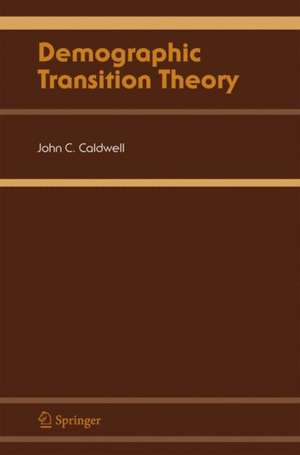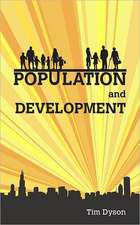Demographic Transition Theory
Autor John C. Caldwell Cu B.K. Caldwell, P. Caldwell, P.F. McDonald, T. Schindlmayren Limba Engleză Hardback – 19 iun 2006
| Toate formatele și edițiile | Preț | Express |
|---|---|---|
| Paperback (1) | 965.52 lei 6-8 săpt. | |
| SPRINGER NETHERLANDS – 19 oct 2010 | 965.52 lei 6-8 săpt. | |
| Hardback (1) | 806.76 lei 38-44 zile | |
| SPRINGER NETHERLANDS – 19 iun 2006 | 806.76 lei 38-44 zile |
Preț: 806.76 lei
Preț vechi: 1061.53 lei
-24% Nou
Puncte Express: 1210
Preț estimativ în valută:
154.37€ • 161.19$ • 127.48£
154.37€ • 161.19$ • 127.48£
Carte tipărită la comandă
Livrare economică 11-17 aprilie
Preluare comenzi: 021 569.72.76
Specificații
ISBN-13: 9781402043734
ISBN-10: 1402043732
Pagini: 428
Ilustrații: VIII, 404 p.
Dimensiuni: 210 x 297 x 32 mm
Greutate: 0.79 kg
Ediția:2006
Editura: SPRINGER NETHERLANDS
Colecția Springer
Locul publicării:Dordrecht, Netherlands
ISBN-10: 1402043732
Pagini: 428
Ilustrații: VIII, 404 p.
Dimensiuni: 210 x 297 x 32 mm
Greutate: 0.79 kg
Ediția:2006
Editura: SPRINGER NETHERLANDS
Colecția Springer
Locul publicării:Dordrecht, Netherlands
Public țintă
ResearchCuprins
The Analytical Approach.- Issues of Early Transition.- Pretransitional Population Control and Equilibrium.- Was There a Neolithic Mortality Crisis?.- Population Intensification Theory.- On Net Intergenerational Wealth Flows: an Update.- Fertility Control in The Classical World: was There an Ancient Fertility Transition?.- Family Size Control by Infanticide in the Great Agrarian Societies of Asia.- The Modern Transition.- Transmuting the Industrial Revolution into Mortality Decline.- The Delayed Western Fertility Decline: an Examination of English-Speaking Countries.- Regional Paths to Fertility Transition.- The Globalization of Fertility Behavior.- Social Upheaval and Fertility Decline.- Demographic Theory: a Long View.- Policy Responses to Low Fertility and its Consequences: a Global Survey.- Explanations of the Fertility Crisis in Modern Societies: a Search for Commonalities.- Back to the Future: the Great Mortality Crises.
Textul de pe ultima copertă
The demographic transition is the change in the human condition from high mortality and high fertility to low mortality and low fertility. Death is now less capricious and most people live long lives. Women no longer average six or seven births but in most economically advanced countries less than two — insufficient to replenish national populations. Most of this dramatic social change has occurred over the last 150 years. But the question remains as to whether this is a completely new phenomenon or whether there has long been an inherent tendency in the human race to maximize survival and to control family size. This study addresses these issues. Part I addresses the situation among hunters and gatherers, traditional farmers and classical civilizations. Part II examines the modern transition, while an introductory chapter synthesizes the findings. An emphasis is placed upon the transmuting of the industrial revolution and rising incomes into longer lives and smaller families. Finally, explanations are sought for below-replacement fertility in Europe and elsewhere. The book has a strong theoretical focus and is unique in addressing both mortality and fertility over the full span of human history. It brings demographers to anthropology, anthropologists to demography, and both to social history.
Caracteristici
A strong theoretical perspective The integration of demographic transition theory over the whole of human existence The integration of mortality and fertility transition theory The examination of the role of the Industrial Revolution An examination of very low fertility in Europe















